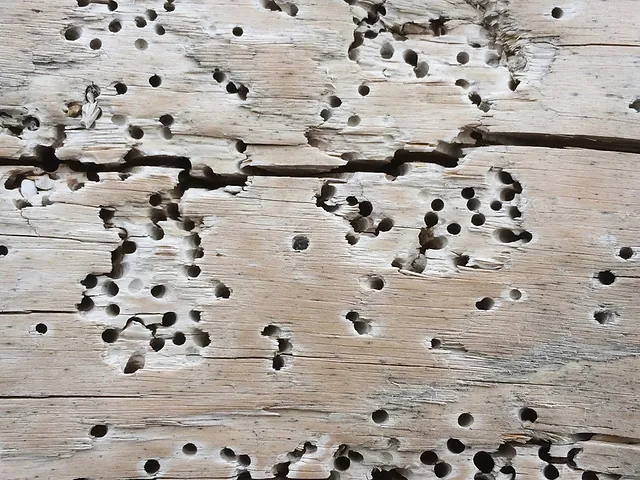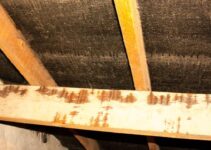The presence of woodworm in a home is usually a worrying sign. While woodworm is mainly found in old buildings, nothing is stopping them from popping up in any home that has wooden elements.
There are 2 main conditions that allow woodworm to thrive: moisture and heat. We’ll discuss everything you need to know about woodworm and heat in this article, as this is useful knowledge for treating a woodworm infestation or preventing it from happening.
Do Woodworms Like Heat?
Woodworms like heat, but equally don’t like it too hot. Moisture is a more important factor for woodworm because it makes their food (wood) easier to chew through. However, woodworm are most active in warmer months, which is when they breed and lay eggs.
There’s no definitive temperature that woodworm enjoy the most. They’ll be most active between 5-20 degrees C, although they can survive warmer and colder temperatures.
Generally, you’ll find they thrive in areas that aren’t heated in your home, such as the attic. But this is because these areas are usually damper and have drafts; it has less to do with the actual temperature.
There are some minor differences between woodworm species, as the term woodworm is a catch-all for several types of beetles that eat wood. However, the temperature range and seasons where they’re most active are pretty standard.

Can Woodworm Survive Central Heating?
Woodworm can absolutely survive central heating, as it won’t reach temperatures high enough to kill them. However, central heating can help reduce or prevent an infestation by removing damp.
This isn’t a guarantee, however, as you’ll probably find you need to deal with the larger issue causing the damp. Central heating will just try it out temporarily.
As mentioned, you’ll typically find woodworm living in areas of the home that aren’t warmed by central heating, such as the attic, basement, garage, etc. But this is because these areas are more prone to damp and drafts rather than them being too warm.
Central heating is usually set to 16-25 degrees C, although it can go higher. These temperatures are nowhere near warm enough to kill woodworm, and going higher will make your home unpleasant.
Instead, you’ll want to address humidity levels if you want to prevent a woodworm infestation. We won’t discuss this in detail here, as we’ve written about it extensively elsewhere.
What Temperature Kills Woodworm?
Woodworm can be killed at temperatures 55 degrees C and above, or -18 degrees C and below. It’s possible to heat treat wood to temperatures high enough to kill woodworm without damaging the wood or its coating. However, this should be done by a professional because it’s a fairly specialist method.
On the reverse end, woodworm won’t survive temperatures of -18 or below. It can still take around 2 weeks for them to die, though, as the cold slows down their bodies to the point where they can no longer function.
We can speed this up by dropping the temperature to -31 degrees, which will kill woodworm in a few days. However, this obviously isn’t very practical because you’ll be hard-pressed to find a sustained temperature that cold. Domestic freezers, for example, sit around -18 degrees C.
Then there’s the obvious problem of getting the wood in the freezer or sustaining a cold enough temperature in another way.
In the UK at least, the weather won’t get cold enough to kill woodworm naturally in this way. We can go the opposite direction, though, and kill them with high temperatures.
How Do You Heat Treat Woodworms?
Using heat to treat woodworm isn’t super complicated, but it can take a while. This depends on the size of the area that needs treatment and whether we’re dealing with structural elements, furniture, etc.
If you’re heat-treating smaller items, you can put them in an oven or sit them near a space heater. While you can’t always guarantee the exact temperature, you can sustain a hot enough environment to kill the woodworm.
You’ll need to leave the item for at least 3 hours, and be sure to monitor the temperature closely.
Another option is to put the item in direct sunlight covered in a black tarp or similar airtight material. Again, you’ll need to keep an eye on the temperature and leave the item in direct sun for as long as possible.
Finally, there’s the heat treatment method for structural elements. We might want to do this if insecticides aren’t an option, or if we need to treat the fungal growth that some woodworms eat.
Unsurprisingly, heating something like an attic can be a bit complex. The first step is to seal the area as much as possible to reduce heat leakage.
The more heat can leak out, the longer it’ll take to reach the desired temperature. We could seal an attic using a fumigation tent, tarps, or something else that’s airtight.
From there, it’s a case of bringing the area up to temperature. This can be done using space heaters, as heating it up isn’t difficult.
An efficient electric space heater should bring a sealed area up to temperature in a few hours. Of course, you won’t want to use a gas-powered heater due to the potential for carbon monoxide build-up.
Throw a fan in to circulate air around the sealed space, and then it’s just a case of waiting. The area needs to be heated for long enough to kill the beetles and their eggs and larvae.
This could take anywhere from a few hours to a few days depending on how deep into the wood they penetrate.
Final Thoughts
It’s entirely possible to kill woodworm with heat, but it’s a specialist process that requires surveys and proper planning.
As such, if it’s something you want to try, you’ll need to find a professional pest exterminator in your area.
But that’s everything you could need to know about heat and woodworm. If you notice you’ve got a woodworm infestation in your home, treating it with heat can be a viable option.


